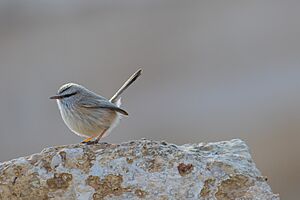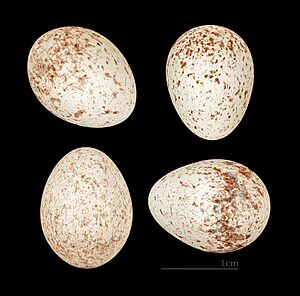Streaked scrub warbler facts for kids
Quick facts for kids Streaked scrub warbler |
|
|---|---|
 |
|
| Sde Boker, Israel | |
| Conservation status | |
| Scientific classification | |
| Genus: |
Scotocerca
|
| Species: |
inquieta
|
The streaked scrub warbler (Scotocerca inquieta) is a small bird, sometimes just called the scrub warbler. It is the only type of bird in its group, called Scotocerca. You can find this bird in northern Africa and parts of south-western Asia.
These birds live in areas near deserts, especially where there are bushes, rocky valleys, and deep cuts in the land called gorges. They usually stay in the same area all year, but sometimes they move around a bit when it's not breeding season. The streaked scrub warbler belongs to its own special bird family, called Scotocercidae.
Contents
About the Streaked Scrub Warbler
The streaked scrub warbler was first officially described in 1830 by a German doctor named Philipp Jakob Cretzschmar. He gave it the scientific name Malurus inquietus. Later, in 1872, a Swedish zoologist named Carl Jakob Sundevall created the group Scotocerca just for this bird.
The name Scotocerca comes from ancient Greek words. Skotos means "dark" or "darkness," and kerkos means "tail." So, it means "dark-tailed." The word inquieta comes from Latin and means "restless." This bird's family, Scotocercidae, was named in 2012.
Different Types of Streaked Scrub Warblers
Scientists recognize eight different types, or subspecies, of the streaked scrub warbler. These types live in different parts of their wide range:
- S. i. theresae: Found in Mauritania and parts of Morocco.
- S. i. saharae: Lives from eastern Morocco to Libya.
- S. i. inquieta: Found from northeast Egypt to northwest Arabia.
- S. i. grisea: Lives in western Saudi Arabia, eastern Yemen, and Oman.
- S. i. buryi: Found in southern Saudi Arabia and western Yemen.
- S. i. montana: Lives in Iran, southern Turkmenistan, southern Tajikistan, and Afghanistan.
- S. i. platyura: Found in Kazakhstan, Uzbekistan, northern Turkmenistan, and southwest Tajikistan.
- S. i. striata: Lives in south-central Iraq, southern Iran, and Pakistan.
Some bird experts even think that the streaked scrub warbler might actually be two different species: the Saharan scrub warbler and the Levant scrub warbler.
What They Look Like
The streaked scrub warbler is a small, shy desert bird. It often holds its tail cocked up over its back. Adult birds are grey-brown on top with thin dark brown streaks. They have a light stripe above their eye and a thin black stripe through their eye.
Their undersides are whitish, with reddish colors on their sides and under their tail. Their chest has fine streaks. The tail is dark brown with a white tip and gets shorter towards the end. Young birds look a bit duller than adults.
The song of the streaked scrub warbler is very unique. It sounds like "zit-zit dweedle-doolredle-doleed."
Where They Live
Streaked scrub warblers prefer open desert areas that have some scattered bushes. They especially like dry riverbeds (called wadis) where there are more plants than in the surrounding desert. You can also find them in rocky areas with bushes in ravines and gorges.
Their Behavior and Life Cycle
Reproduction
Streaked scrub warblers build their nests in low bushes, usually no higher than 1.5 meters (about 5 feet) off the ground. Their nest is shaped like a dome and is made from grass and small twigs. Inside, it's lined with soft materials like feathers, animal fur, and plant fluff.
Interestingly, their nest usually has one or two side entrances. If there are two, the second one is only used for leaving the nest! A female bird usually lays 3 to 5 eggs, but sometimes it can be 2 to 5. The eggs hatch in about two weeks, and the young birds are ready to fly about two weeks after that.
Food and Feeding
These birds mostly eat insects. However, seeds can also be a very important part of their diet, especially during the winter. They look for food on the ground, digging through fallen leaves and other bits under bushes. They also search in small holes and cracks. Sometimes, they will also look for food up in the plants.
Conservation Status
The streaked scrub warbler lives across a very large area. While they might be rare in some places, they are common in others. Scientists haven't found any major threats to these birds. Their population is thought to be stable or only slightly decreasing. Because of this, the International Union for Conservation of Nature (IUCN) has listed their conservation status as "least concern". This means they are not currently at risk of disappearing.
Images for kids






